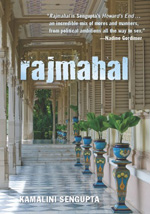

The Feminist Press, paperback, 9781558616080
The ghosts of Kamalini Sengupta's Rajmahal fret and fume over renovations made to the Calcutta mansion as it is sold and divided into six apartments. Even more disturbing is the motley cross-section of fashionable Calcutta society that moves into those apartments. Looking to expand his influence and business, Sardar Bahadur Ohri, a successful Sikh builder, constructed and relocated his family to the Rajmahal in Chowringhee, the hub of British Calcutta, in 1910—the year before the capitol of India was moved to Delhi. Thirty years later, nearing death, the Sardar has sold the Rajmahal and returned to his native Punjab to contemplate the Golden Temple in his last days. The Ohri family has retained the ground floor apartment, and the new owners, the Muslim Malliks, claim the top floor apartment. The four apartments on the two intervening floors are occupied by the Stracheys, a British family; the Petrovs, a Russian-Bengali family; the Mojumdars, a zamindari Bengali family; and the Roman Catholic Normans with David Norman's widowed sister, Maudie Jessup.
In 1947, the British Raj came to an end as India gained its independence from imperial rule. The Rajmahal and its inhabitants remained. Now middle-aged, with their children scattered around the world, each of the couples must face a new India and the challenges of growing old. The Rajmahal itself, personified in the novel, has to cope with a crumbling elegance and inhabitants who gradually pass away and leave empty spaces in the once-elegant and impressive mansion. Unlike Salman Rushdie's Midnight's Children which confronts independent India in a brilliant headlong rush, Sengupta's Rajmahal microcosm unfolds slowly and nostalgically. The major characters in Rajmahal are privileged and wealthy. They live through the momentous cataclysms of twentieth-century India—the famines and massacres, the struggle for and achievement of independence—but their personal lives are largely unchanged. Jack and Myrna Strachey, somewhat disappointed by the loss of an economic knighthood, nevertheless decide to remain in India after independence, enjoying the privileged social life that would be denied them back in Britain. Anatoly Petrov, Russian founder of a Bengali theatre, continues to produce plays starring his brilliant actress wife, Deepa, while pondering the injustices of Indian society in his journals. Childless, Proshanto and Mohini Mojumdar adopt their nephew Rudro, and thus ensues a financial battle with his father, Shudhangshu. The bewildered Normans retire to Canada to join their children, leaving behind Maudie, who stubbornly and drunkenly refuses to leave the Rajmahal.
Into the aging realm of the Rajmahal moves Surjeet Shona, descendant of the Ohri family, but a hybrid whose ancestors not only numbered those noble Sikhs, but also the aristocratic Bengali family that had originally owned the property on which the Rajmahal stood. "The Rajmahal, having got back this Ohri-cum-Sheetanath as a resident, was beside itself with emotion. If it could, it would have shed sentimental tears when the tall strapping beauty, whom it had last seen twenty-six years ago as a newborn baby walked in. The ghosts murmured approvingly". Surjeet is the silk that sews together the Rajmahal stories and weaves her own web.
Kamalini Sengupta, a journalist and documentary filmmaker, has illuminated a multi-faceted view of post-colonial
India in the delightfully engaging Rajmahal, her second novel.
Read an interview with Kamalini Sengupta in World Literature Today: http://www.ou.edu/worldlit/nov10-interview.html
